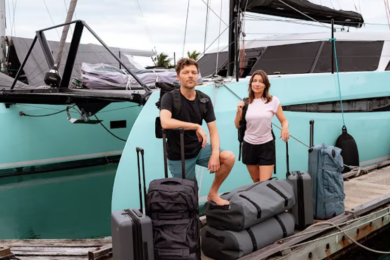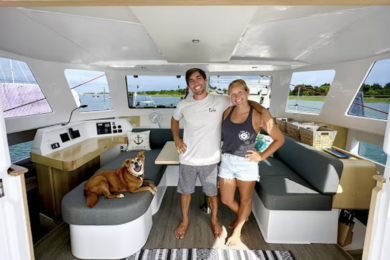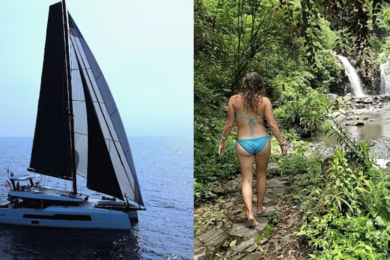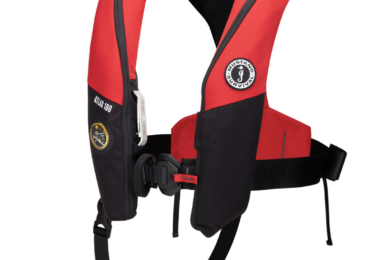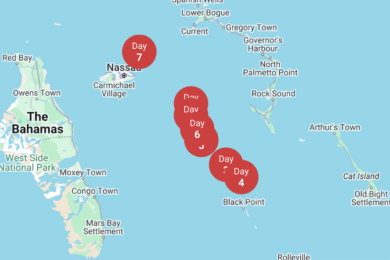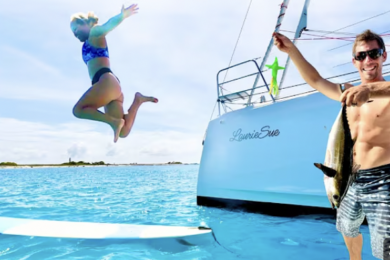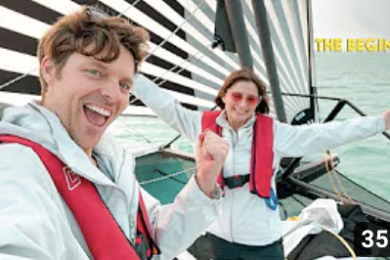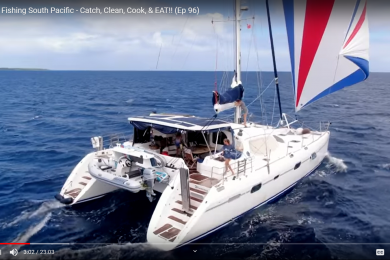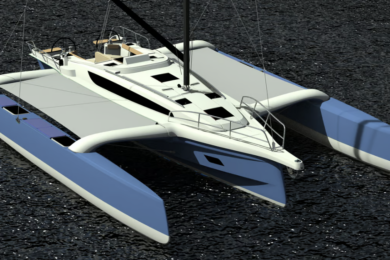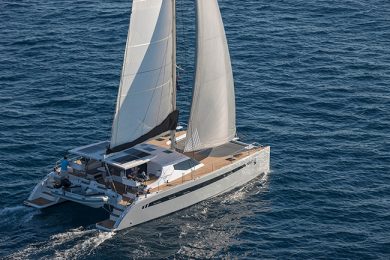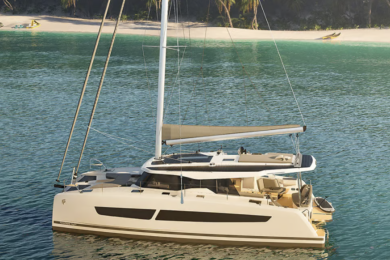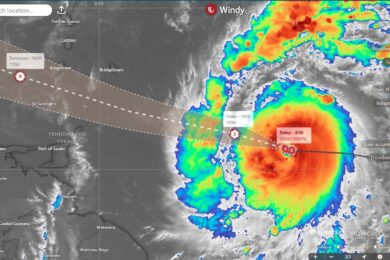
Safety and comfort aboard one family’s floating home sweet home (Published Fall 2009)
For more than four years now, Zia has been much more than just a boat to us; she is our family home and the center of our little universe. We eat, sleep, play and learn on Zia, and with a little effort on our part, she takes great care of us.
Zia is almost like two separate boats. When we are barreling along at sea, she is in her element. With the wake hissing from the stern and her rigging as taut as a steel bar, Zia is a high-tech machine made to eat up the miles in speed and comfort. She glides, surfs or hammers her way over the sea, depending on the conditions. But when we get into port and are swinging calmly at anchor, she changes personality and becomes a welcoming home with a shady porch and two sets of steps leading down to the pool. Many of Zia’s features, both as a sailboat and a home, go a long way toward making our cruising lifestyle work smoothly.
SWITCH 51 – NUMBER 6
Zia is a 51-foot Switch catamaran built in France in 2002 by the now defunct Sud Composites. They built about 16 of them, and Zia was number six. We are the second owners, the first being a family much like ours, with two kids aboard. They sailed her from France through the Caribbean and South Pacific and ended up in New Zealand, where they shipped her back to the U.S. and put her up for sale.
When we bought Zia, she had 20,000 miles on the log. After four years, we are approaching 50,000 miles. She is holding up very well mechanically, and looking at her still makes my heart skip a beat. We found Zia with the help of a rare boat broker who has experience in both catamarans and living aboard with a family. Our broker’s advice and suggestions were right on the money, but more importantly, he managed to get us thinking like cruisers rather than dreamers well before we bought a boat.
Zia is light and powerful, with three furling headsails, a high bridge deck clearance and dagger boards for pointing upwind. She has twin Yanmar 40 horsepower diesels with folding props, making it simple to maneuver under power. Her shallow draft (three feet, eight inches) was a big plus in the skinny waters of the Bahamas and allowed us to explore cays that were too shallow for the crowds. I know that 51 feet sounds like a big boat, but she weighs in much lighter than many other 45-foot catamarans.
Zia’s three furling headsails are a lazy sailor’s dream (and a dream for climbing kids). The center sail is a standard genny that is our default sail for most conditions. It sheets in to the cabin top at a close angle to help us point upwind. When sailing the genoa deeper downwind, we rerun the sheet out to a block on the leeward rail to keep the sail full. For going off the wind in less than 20 knots apparent, we use the gennaker, which is rigged on a five-foot retractable bowsprit. Just roll it out and whomp! It’s like an instant spinnaker and the boat loves it. We can tack or gybe it just like a genny, and when the wind pipes up or we need to turn upwind above 60 degrees apparent, we just roll it back in.

On long downwind legs, we have tacked the gennaker to the windward hull, which allows us to keep the sail full while sailing deeper downwind. When we get into heavier breeze, we roll out the staysail, which is essentially a roller-furled storm sail. Quantum Sails in Annapolis has built all of our sails except for the staysail, which is original equipment. They designed a strong but fast cruising mainsail with six battens and more roach than the original (“Just because we can,” they said). They also added our Zia logo six feet high across the top panel of the mainsail. We have three slab reefs that are controlled from the base of the mast—happily, this is usually Christy’s job since it gets kind of wet up there.
When sailing upwind, we lower our daggerboards to increase the draft to almost nine feet and keep the leeway in check. If anyone ever tells you that you don’t really need to sail upwind, they must have a powerboat. We always seem to need to sail upwind, and it would break our hearts to have to motor so much of the time. We also have an asymmetrical cruising chute for the occasions when we have to go deep downwind for days at a time.

For those times when we do need to motor, we usually use a single engine since we can motor at 6.5 knots at cruising rpm and two engines only gets us up to 7.5 knots. Using just one of our engines at a time cuts our fuel bill in half and means that I spend a lot less time sweating and cursing in paradise while maintaining the engines.
We carry 220 gallons of fuel, which gives us a potential “no wind range” of about 1,500 miles. We generally don’t carry full fuel unless we are heading off on a passage. The engine rooms have lots of space, but I still have to contort myself like a lab rat to reach various spots. It is interesting to note that we gain about half a knot by feathering the prop that is not pushing the boat. Our Volvo three-blade folding props make a big difference in performance.
SAFETY FIRST
We have learned that you really have to consider safety as a way of life when you live on a boat. All guests get a comprehensive safety talk when they come on board, in addition to instructions on how to use the heads. We wear West Marine inflatable PFDs with built in harnesses, rescue flashers and jacklines at night or in nasty weather. The kids have form-fitting PFDs with whistles attached.
On the stern, we have a MOM 8 Man Overboard Module that will launch a lighted flag with a sea anchor if someone goes over the side. To get him back aboard, we have a Lifesling, although we would probably just haul him up the swim steps. We have a Switlik six-person life raft, which they say should only be used in case of fire since Zia is, dare I say, unsinkable.

We sail with our ditch bag under the nav station. It has all of the requisite gear in one handy package should the worst happen. If the worst does happen, we have a 406 EPIRB and a Spot satellite locator system (www.findmespot.com). The Spot system offers all kinds of great features for emergency help and is very inexpensive.
ELECTRONICS
We are ex-computer people, so we elected to use a laptop for navigation. Our trusty Dell provides navigation, communication (e-mail and Skype), and entertainment (a DVD player). We use Nobeltec MaxPro software for navigation and are very happy with it. True, the charts aren’t cheap, but they are highly accurate, and accuracy is what it’s all about when you are feeling your way into a harbor at night or in fog.

For weather, we use Weathernet from www.ocens.net, or SailMail weather. Weathernet offers a huge amount of weather data, including GRIB files, at a reasonable cost. You can access it with the Internet, e-mail or a satphone. We can also use SailMail to get e-mail on our SSB radio, but we have found it much easier to pay a little bit more and use the satphone or Internet connection. We keep an older laptop with all of the nav software and charts installed as a backup, and we carry paper charts as well.
WE FLY WITH WI-FI
Wi-Fi is getting more and more prevalent everywhere we go. So far, we have been able to get Wi-Fi in about 95 percent of the harbors and marinas that we have visited. Not only do we get e-mail and web capability, but we are also able to call friends and family for free using Skype (www.skype.com).
To avoid having to schlep the laptop to an Internet café, we use a 5milewifi Wi-Fi booster kit (www.5milewifi.com) with a 9 dbi antenna mounted on the first spreader. This increases our range by a factor of 30 or more, and almost always allows us to have Wi-Fi right on board — we have connected as far as nine miles out. We then network all four computers (yes, we each have a computer) via an inexpensive hub so that we can all be online. Having wireless bandwidth aboard the boat is a huge benefit when it comes to getting weather, finding tourist information, accessing Google Earth or just plain old staying in touch.
LIVING GEAR
One of the best modifications that we made to Zia for quality of life is our solar array. We added three 175-watt solar panels above our dinghy davits on a custom bracket. The panels receive full sun on the davits, and as a side benefit they shade the dinghy nicely.
We set up the system with an Outback (www.outback.com) controller to harness all of the power and channel it into our hungry 200-amp hour battery bank. It was designed as a “set it and forget it” system and it has lived up to its billing. The previous owner of Zia had to run the 3.5-killowatt genset about three hours per day, every day, to keep the batteries topped up. We only use the generator once every few weeks, usually if it has been very cloudy, or if we have had power hungry guests on board.
THERE’S NO A/C, BUT WE DO HAVE ICE CUBES!
What do we have that sucks up all of this power? Although we have no air conditioning or heat, we have almost all of the appliances that we had at home, including a washing machine, microwave, toaster oven, coffee pot, fridge, freezer, vacuum, power tools and more. All of these amenities run off our Mastervolt 2500-watt inverter, so we don’t need to run the generator.
We upgraded Zia’s refrigeration and installed a 12-volt dual Frigoboat system with keel coolers. It is another “set it and forget it” system that is penurious with power and nearly silent as well. We can serve ice in our drinks and keep the fish that we catch frozen rock solid. The system is in a cabinet under the fridge and is easily accessible.

Our watermaker is a big help in terms of quality of life on board, since we carry only 100 gallons of fresh water. We have a Spectra unit that makes up to 14 gallons per hour. Although it is not quite “set it and forget it,” once you learn the tricks it works well with minimum maintenance. It is located amidships in the starboard hull hallway. We try hard to keep three water jugs full and cold, which leaves the family well hydrated.
RACERS KNOW DIDDLY ABOUT ANCHORING
As racers in Annapolis, we never thought twice about the anchor, except to remember to take it off of the boat every Wednesday night. It has been a steep but important learning curve to get the anchoring process down pat. The price for a screw up is a lost night of sleep at best, and a lost boat at worst.
We have slept much better at night since we upgraded our anchor to a 66-pound Spade. We have 285 feet of 10-millimeter chain, and we use as much of it as we can in each anchorage. If we expect a blow, we just shackle our Fortress 37 about 15 feet up the chain from the Spade and set ‘em both. This is what sweet dreams are made of. We learned the dual anchor tidbit from our well-worn copy of Steve Dashew’s Offshore Cruising Encyclopedia.
MADE IN THE SHADE
Our bimini is a thick aluminum frame strung with the same trampoline material as the bow and covered with Sunbrella. It shades the whole cockpit and has side and stern shades as well. It is a great place to sleep, sunbathe or work on the sail. Shade is a valuable commodity when cruising, and a full-time bimini is a key piece of equipment for us.
THE FINAL TOUCH
One thing was missing when we launched our ship — a figurehead. We couldn’t afford to carve a beautiful siren to grace our bows, so we came up with the next best thing. We are kind of a Barbie boat anyway.

